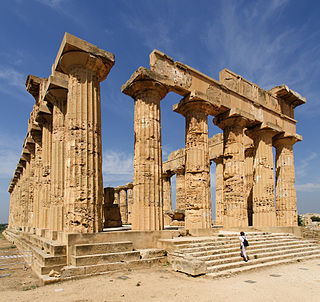
Selinunte was a rich and extensive ancient Greek city of Magna Graecia on the south-western coast of Sicily in Italy. It was situated between the valleys of the Cottone and Modione rivers. It now lies in the comune of Castelvetrano, between the frazioni of Triscina di Selinunte in the west and Marinella di Selinunte in the east.

Magna Graecia is a term that was used for the Greek-speaking areas of Southern Italy, in the present-day Italian regions of Calabria, Apulia, Basilicata, Campania and Sicily; these regions were extensively populated by Greek settlers starting from the 8th century BC.

Ancient Greek architecture came from the Greeks, or Hellenes, whose culture flourished on the Greek mainland, the Peloponnese, the Aegean Islands, and in colonies in Anatolia and Italy for a period from about 900 BC until the 1st century AD, with the earliest remaining architectural works dating from around 600 BC.

The Doric order is one of the three orders of ancient Greek and later Roman architecture; the other two canonical orders were the Ionic and the Corinthian. The Doric is most easily recognized by the simple circular capitals at the top of the columns. Originating in the western Doric region of Greece, it is the earliest and, in its essence, the simplest of the orders, though still with complex details in the entablature above.

Greek temples were structures built to house deity statues within Greek sanctuaries in ancient Greek religion. The temple interiors did not serve as meeting places, since the sacrifices and rituals dedicated to the deity took place outside them, within the wider precinct of the sanctuary, which might be large. Temples were frequently used to store votive offerings. They are the most important and most widespread surviving building type in Greek architecture. In the Hellenistic kingdoms of Southwest Asia and of North Africa, buildings erected to fulfill the functions of a temple often continued to follow the local traditions. Even where a Greek influence is visible, such structures are not normally considered as Greek temples. This applies, for example, to the Graeco-Parthian and Bactrian temples, or to the Ptolemaic examples, which follow Egyptian tradition. Most Greek temples were oriented astronomically.

Thermos was an ancient Greek sanctuary, which served as the regular meeting place of the Aetolian League. Its focal point was the temple of Apollo Thermios of about 630 to 610 BC, "one of the earliest developed Doric temples known and a monument of primary importance for our knowledge of the history of Greek architecture". The most famous survivals are the Archaic terracotta metopes decorated with painted scenes from mythology, which are among the earliest examples of this art form in Greece. What is left of these, and other finds from the site, are now in the museum at Thermos, with a selection of the best pieces in National Archaeological Museum, Athens.
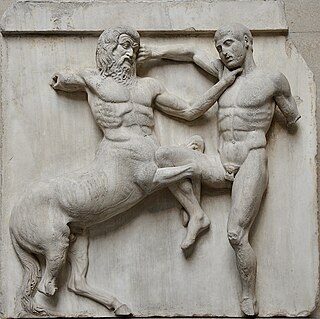
In classical architecture, a metope is a rectangular architectural element that fills the space between two triglyphs in a Doric frieze, which is a decorative band of alternating triglyphs and metopes above the architrave of a building of the Doric order. Metopes often had painted or sculptural decoration; the most famous example are the 92 metopes of the Parthenon, some of which depict the battle between the Centaurs and the Lapiths. The painting on most metopes has been lost, but sufficient traces remain to allow a close idea of their original appearance.
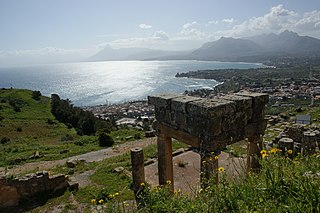
Soluntum or Solus was an ancient city on the Tyrrhenian coast of Sicily, near present-day Porticello in the comune of Santa Flavia, Italy. The site is a major tourist attraction. The city was founded by the Phoenicians in the sixth century BC and was one of the three chief Phoenician settlements in Sicily in the archaic and classical periods. It was destroyed at the beginning of the fourth century BC and re-founded on its present site atop Monte Catalfano. At the end of the fourth century BC, Greek soldiers were settled there and in the 3rd century BC the city came under the control of the Roman Republic. Excavations took place in the 19th century and in the mid-20th century. Around half of the urban area has been uncovered and it is relatively well preserved. The remains provide a good example of an ancient city in which Greek, Roman and Punic traditions mixed.
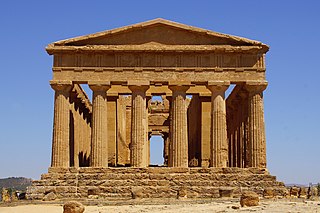
The Valle dei Templi, or Valley of the Temples, is an archaeological site in Agrigento, Sicily. It is one of the most outstanding examples of ancient Greek art and architecture of Magna Graecia, and is one of the main attractions of Sicily. The term "valley" is a misnomer, the site being located on a ridge outside the town of Agrigento.

The Temple of Artemis is an Archaic Greek temple in Corfu, Greece, built in around 580 BC in the ancient city of Korkyra, now called Corfu. It is found on the property of the Saint Theodore monastery, which is located in the suburb of Garitsa. The temple was dedicated to Artemis. It is known as one of the first Doric temples built exclusively of stone. It is also considered one of the first buildings to have incorporated all the elements of the Doric architectural style. Sharing these historical records with the Temple of Apollo in Syracuse in Sicily (Italy). Very few Greek temple reliefs from the Archaic period have survived, and the large fragments of the group from the pediment are the earliest significant survivals. It was excavated from 1911 onwards.

The Antonino Salinas Regional Archeological Museum is a museum in Palermo, Italy. It possesses one of the richest collections of Punic and Ancient Greek art in Italy, as well as many items related to the history of Sicily. Formerly the property of the Oratory of Saint Philip Neri, the museum is named after Antonino Salinas, a famous archaeologist and numismatist from Palermo who had served as its director from 1873 until his death in 1914, upon which he left it his major private collection. It is part of the Olivella monumental complex, which includes the Church of Sant'Ignazio all'Olivella and the adjoining Oratory.
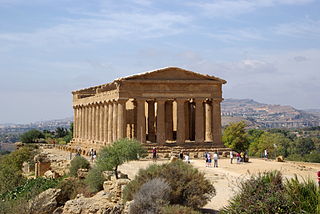
The Temple of Concordia is an ancient Greek temple of Magna Graecia in the Valle dei Templi in Agrigento on the south coast of Sicily, Italy. It is the largest and best-preserved Doric temple in Sicily and one of the best-preserved Greek temples in general, especially of the Doric order. It is located a kilometer east to the Temple of Heracles.

The Temple of Heracles or Temple of Hercules is an ancient Greek temple of Magna Graecia in the ancient city of Akragas, located in the Valle dei Templi in Agrigento, Italy.

The Temple of Apollo is one of the most important ancient Greek monuments of Magna Graecia on Ortygia, in front of the Piazza Pancali in Syracuse, Sicily, Italy.
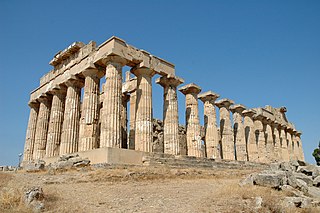
Temple E at Selinus in Sicily is a Greek temple of Magna Graecia of the Doric order. It is found on the hill to the east of the city's acropolis. Temple E is also known as the Temple of Hera because an inscription found on a votive stela indicates that it was dedicated to Hera; however, some scholars argue that it must have been dedicated to Aphrodite on the basis of structural parallels. It was built towards the middle of the fifth century BC on top of the foundations of a more ancient building. It is the best conserved of the temples of Selinus but its present appearance is the result of anastylosis performed—controversially—in 1959, by the Italian archaeologist Jole Bovio Marconi.
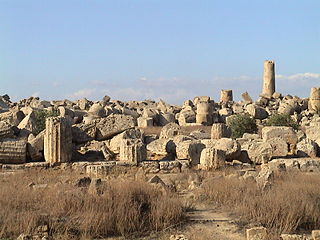
Temple F at Selinus in Sicily is a Greek temple of Magna Graecia of the Doric order. It was probably dedicated to Dionysus or Athena and is one of the three temples on the East Hill. The temple's dating is very uncertain, but it probably belongs to the middle of the sixth century BC.

The Temple of Athena is a Greek temple of Magna Graecia found at Paestum, in Capaccio Paestum, a comune in the province of Salerno in the Campania region of south-western Italy. It was built around 500 BC and was for some time incorrectly thought to have been dedicated to Ceres, but as a result of the recovery of numerous statuettes in terracotta depicting Athena, it is now thought to have been dedicated to her.

The Heraion at Foce del Sele is an archaeological site consisting of an Ancient Greek sanctuary complex dedicated to the goddess Hera in what was Magna Graecia. When built, the complex was located at the mouth of the Sele, approximately 8 km (5.0 mi) north of the Greek city of Poseidonia that was famous for its three standing Greek temples. Due to the deposition of alluvial sediment by the river, the site now is approximately 2.3 km (1.4 mi) from the modern coast.
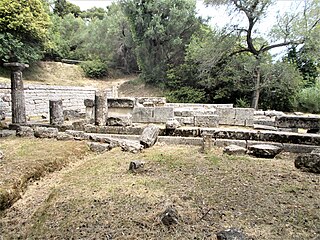
Kardaki Temple is an Archaic Doric temple in Corfu, Greece, built around 500 BC in the ancient city of Korkyra, in what is known today as the location Kardaki in the hill of Analipsi in Corfu. The temple features several architectural peculiarities that point to a Doric origin. The temple at Kardaki is unusual because it has no frieze, following perhaps architectural tendencies of Sicilian temples. It is considered to be the only Greek temple of Doric architecture that does not have a frieze. The spacing of the temple columns has been described as "abnormally wide". The temple also lacked both porch and adyton, and the lack of a triglyph and metope frieze may be indicative of Ionian influence. The temple at Kardaki is considered an important and to a certain degree mysterious topic on the subject of early ancient Greek architecture. Its association with the worship of Apollo or Poseidon has not been established.

The so-called Temple of "Hera", otherwise known as Temple D, is a Greek temple in the Valle dei Templi, a section of the ancient city of Agrigentum in Sicily.

























